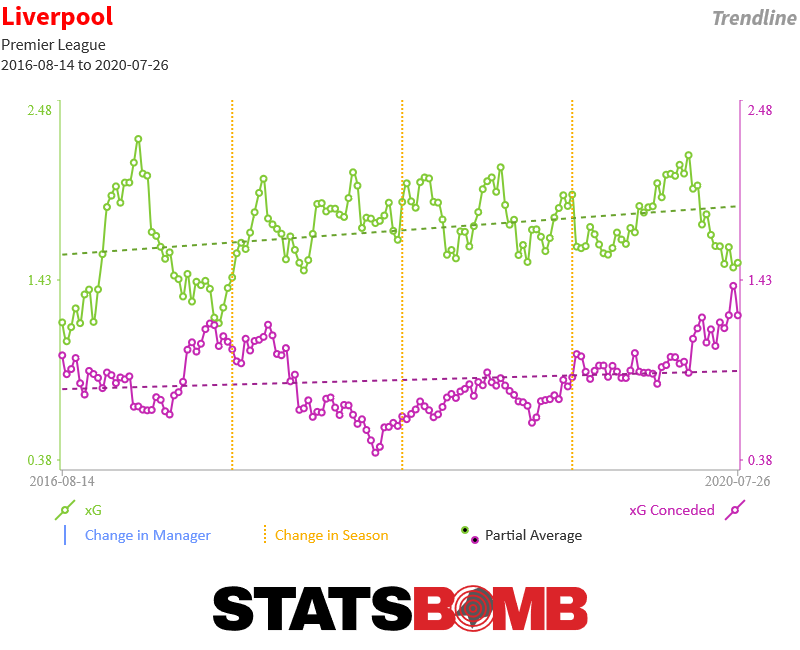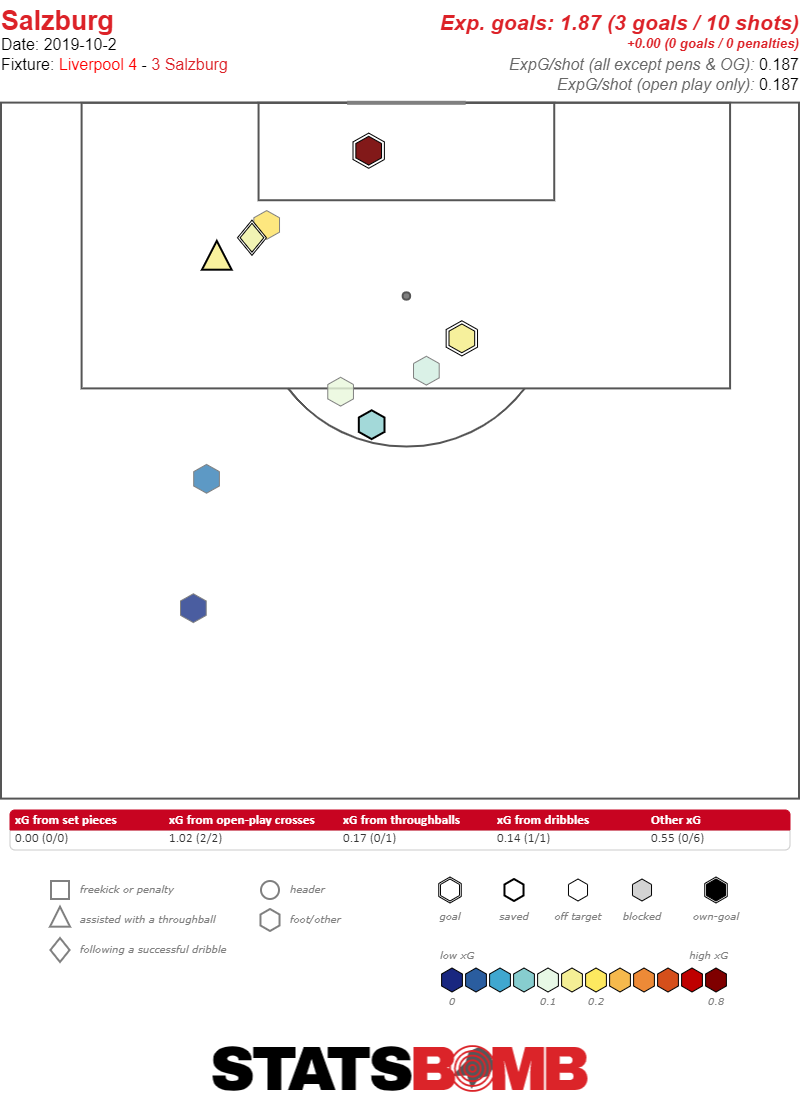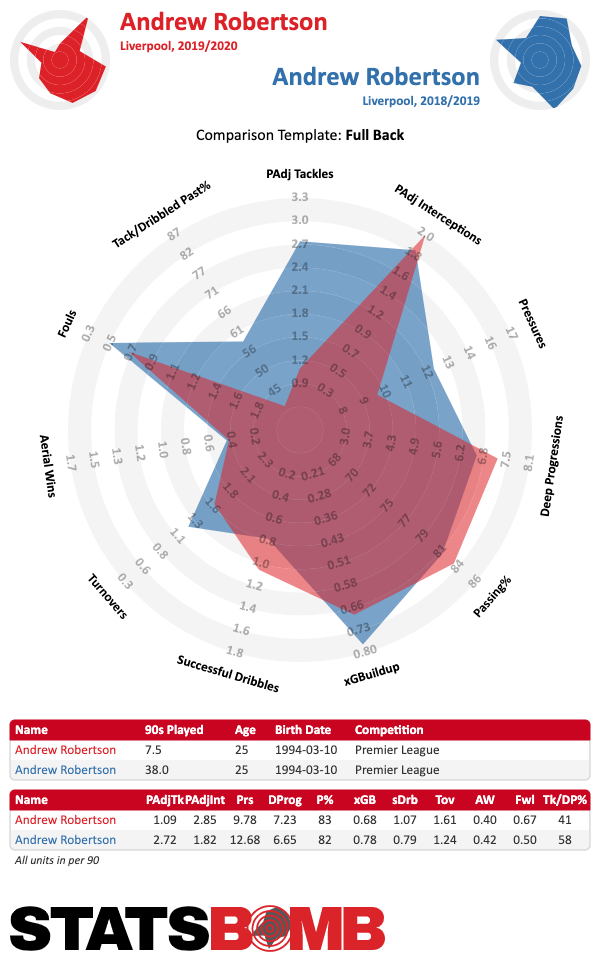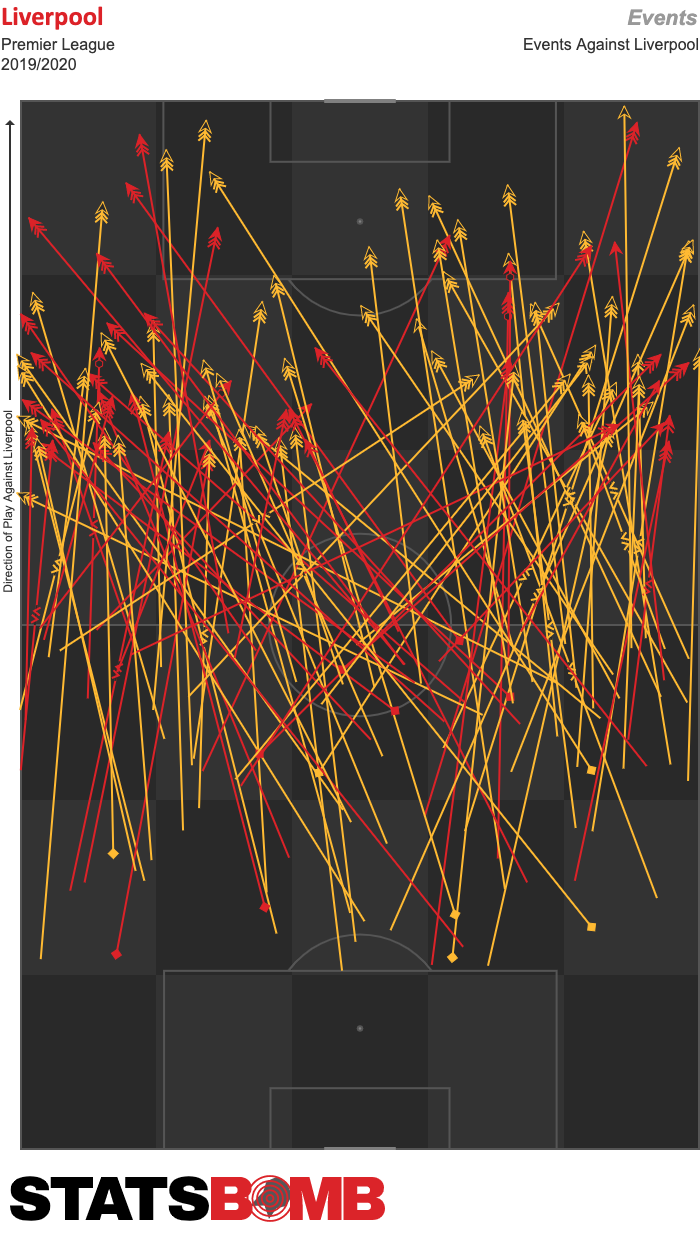There’s an attacker in England who, after two seasons of utter dominance, has fallen down to Earth with good but not great production. His team’s record remains surprisingly strong, but underneath the hood, their expected goals record belies a team not actually at the station they expected to be, lucky to be above their rivals in the table. I’m talking, of course, about Mo Salah and Liverpool. It’s hard to complain about a team that has taken 21 of 21 points in the league and a guy who has three non-penalty goals and three assists in seven league matches, but the statistical record is flashing some warning signs. In 2017-2018, Salah came into the Premier League and set the world on fire. He took four shots per game, and racked up buckets of high quality chances, dribbling past would be defenders with aplomb, leaving them on the ground, and firing shots from the center of the box. His 0.6 expected goals per 90 minutes and 0.2 open play expected goals assisted per 90 led him to a Premier League Player of the Year. Last season, he came back to earth but was still excellent, with 0.4 xG per 90 and 0.22 open play xG assisted per 90. This season though? Through seven league matches Salah has just 0.37 xG per 90 and 0.05 xG assisted per 90. He’s still getting tons of touches in the box, more than last year in fact. But Salah is completing just 30% of his passes in the box or into the box to teammates, as compared to almost 50% last year. He’s also taken just a single shot with his feet within nine yards of goal this season. He had 29 such shots over the past two seasons combined. Perhaps that will change, but he does look somewhat less explosive than he did the last couple years, not turning the corner in the box with the same gusto. Two seasons of 4500 minutes plus playing in international tournaments may be taking its toll. Interestingly, the attack remains near last year's heights. Roberto Firmino and Sadio Mane have been excellent. While the team is not creating from open play like it did two seasons ago, they are finding more goals from set pieces. With the team treading water offensively, Liverpool’s xGD is a far cry from the heights of last season, and quite frankly, the second half of last season is a far cry from the first half:  As we saw against Salzburg, it is the defense that is struggling in particular, shipping significantly more high quality chances than it did last season.
As we saw against Salzburg, it is the defense that is struggling in particular, shipping significantly more high quality chances than it did last season.  Perhaps the defense is struggling because the defenders are being asked to do too much in attack. Klopp played Andrew Robertson over 4500 minutes last season, rarely rotating his hyper-athletic left back who also was one of the team’s major creative engines. The wear on Robertson appears to be showing, with Robbo getting beaten much more consistently this season.
Perhaps the defense is struggling because the defenders are being asked to do too much in attack. Klopp played Andrew Robertson over 4500 minutes last season, rarely rotating his hyper-athletic left back who also was one of the team’s major creative engines. The wear on Robertson appears to be showing, with Robbo getting beaten much more consistently this season.  Trent Alexander-Arnold who also played a huge number of minutes at such a demanding position is also struggling to meet last year’s heights and is also one of Liverpool’s key creators. Last season and this season Liverpool got much of its creative output from its two fullbacks, but have perhaps ramped up their intensity even higher as a result of the midfield’s lack of ball progression. Alexander-Arnold and Robertson are combining for over 5.5 touches in the box so far this season, up significantly from about 4 combined last season. Robertson has even more deep progressions this year than last, one of his few increases in output. Robertson’s charging run into the box for a goal against Salzburg was a wonderful piece of skill, but also perhaps indicative of a team that has turned to its fullbacks to do too much, especially given that in the same move he was the player to advance the ball into the opposition half from his own defensive zone. Even so, last year Liverpool asked a lot of its fullbacks and were rock solid defensively. Teams do seem to be exploiting the space left by Alexander-Arnold more ruthlessly. The number of successful passes into areas he nominally would be controlling have increased significantly on a per 90 basis this season. But perhaps the other major change has been the loss of Alisson to start the season. Alisson is significantly more aggressive off his line than Adrian.
Trent Alexander-Arnold who also played a huge number of minutes at such a demanding position is also struggling to meet last year’s heights and is also one of Liverpool’s key creators. Last season and this season Liverpool got much of its creative output from its two fullbacks, but have perhaps ramped up their intensity even higher as a result of the midfield’s lack of ball progression. Alexander-Arnold and Robertson are combining for over 5.5 touches in the box so far this season, up significantly from about 4 combined last season. Robertson has even more deep progressions this year than last, one of his few increases in output. Robertson’s charging run into the box for a goal against Salzburg was a wonderful piece of skill, but also perhaps indicative of a team that has turned to its fullbacks to do too much, especially given that in the same move he was the player to advance the ball into the opposition half from his own defensive zone. Even so, last year Liverpool asked a lot of its fullbacks and were rock solid defensively. Teams do seem to be exploiting the space left by Alexander-Arnold more ruthlessly. The number of successful passes into areas he nominally would be controlling have increased significantly on a per 90 basis this season. But perhaps the other major change has been the loss of Alisson to start the season. Alisson is significantly more aggressive off his line than Adrian.  While Virgil Van Dijk can do almost everything, perhaps he cannot cover for two fullbacks and a less aggressive keeper. Looking at the radars of the two keepers, you can see that Alisson’s “GK Aggressive Distance” - where he makes tackles, interceptions, etc. - is much farther off the line than Adrian, who has otherwise filled in quite admirably. Liverpool’s high line, and very high fullbacks, have survived because Van Dijk is so good at filling in space, but also because their goalkeeper was perhaps also good at protecting the team from dangerous long balls into space. Using Statsbomb’s IQ tactics we can look at how well teams are completing passes against Liverpool that start from above the box in their own half and go into the final third. Last season teams completed 29% of such passes and completed 4.6 such passes per match. So far those numbers are 39% and 6.3.
While Virgil Van Dijk can do almost everything, perhaps he cannot cover for two fullbacks and a less aggressive keeper. Looking at the radars of the two keepers, you can see that Alisson’s “GK Aggressive Distance” - where he makes tackles, interceptions, etc. - is much farther off the line than Adrian, who has otherwise filled in quite admirably. Liverpool’s high line, and very high fullbacks, have survived because Van Dijk is so good at filling in space, but also because their goalkeeper was perhaps also good at protecting the team from dangerous long balls into space. Using Statsbomb’s IQ tactics we can look at how well teams are completing passes against Liverpool that start from above the box in their own half and go into the final third. Last season teams completed 29% of such passes and completed 4.6 such passes per match. So far those numbers are 39% and 6.3.  Simpler explanations for Liverpool’s statistical (though otherwise non-existent) struggles may also suffice. Seven matches is a small sample size. Virgil Van Dijk could have experienced a career year at 27 and still be great, just not superhuman this season. Of course, Liverpool may well start producing at last year’s levels again soon. Still, it’s important not to get fooled by the record and to see that maybe there are some cracks in what otherwise seems like an unstoppable juggernaut.
Simpler explanations for Liverpool’s statistical (though otherwise non-existent) struggles may also suffice. Seven matches is a small sample size. Virgil Van Dijk could have experienced a career year at 27 and still be great, just not superhuman this season. Of course, Liverpool may well start producing at last year’s levels again soon. Still, it’s important not to get fooled by the record and to see that maybe there are some cracks in what otherwise seems like an unstoppable juggernaut.
2019
There are statistical warning signs lurking below Liverpool's perfect Premier League start
By admin
|
October 4, 2019